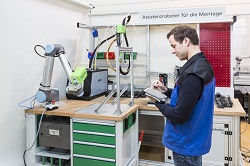Complementary division of labour between robots and humans on the assembly line
Talk of increased industrial automation opens up fears about the erosion of employment opportunities and the assembly line is often held up as being at the forefront of these concerns. However, for a variety of procedural and technical reasons, assembly line automation, is actually quite hard, especially for smaller and order-driven batch sizes, and so much is outsourced to countries with a cheaper labour force. The EU-funded LIAA(opens in new window) (Lean Intelligent Assembly Automation) project has contributed to efforts that enable symbiotic human-robot cooperation. Robots excel at achieving high productivity alongside high precision, performing for long periods without energy exhaustion, in structured environments. Whereas, humans are well suited to accomplish tasks requiring planning and reasoning, and adapt quickly to unpredictable or unforeseeable situations. LIAA has designed scenarios where humans and robots work in close cooperation using the same workplaces, tools and fixtures, helping safeguard European jobs along the way. The best of both worlds Industrial automation has typically been developed for capital-intensive large-volume manufacturing processes. These frequently are set up with the explicit aim of replacing human operators. However, the result is often costly with complex systems which seek to separate robot and human tasks, sometimes with physical barriers. The LIAA project takes a more symbiotic approach as the project coordinator Mr. Martin Naumann, explains, “When robots and humans complement one another, it reduces investment in expensive equipment to help the robot cope with an unstructured environment as well as avoiding strenuous and repetitive work that doesn’t maximise human capabilities while actually also damaging health.” The LIAA team developed a range of solutions to facilitate symbiotic working including software for intuitive robot programming, a simulation tool for end users, system integrators and robotics providers to effectively simulate systems and The World Model, a runtime module combining static and dynamic information for reviewing the status of resources (human/machinery/robot) and calculating task progress. However, getting to this point necessitated the integration of various enhanced technologies into one framework and workflow, that could be easily adopted by non-experts in a reasonable amount of time. As Mr. Naumann, reflects, “We overcame this challenge by subdividing the workflow into different phases, principally workplace design, workplace configuration and workplace runtime and production planning. Each set-up had different users, which we supported with holistic solutions.” Furthermore, to be flexible enough to be deployable in different SME production environments, the team’s symbiotic solution was successfully tested with five end-users which represented a range of scenarios from printed circuit boards (pick and place, soldering operations) to vehicle roof racks manufacturing (pick and place, riveting operations). Safety was paramount to the technical developers and so the project developed and applied a Computer-Aided Risk Assessment Tool to aid system-integrators identify potential hazards and suggest appropriate mitigation measures. Crucially, solutions not only complied with international standards, such as ISO 10218(opens in new window), but as existing regulations cater for very limited industrial human-robot interactions, LIAA actually fed back learning to those responsible for EU robot co-worker safety regulations. Reaping the rewards of symbiotic workplaces It is anticipated that the symbiotic robot solutions developed by the LIAA project will enable more flexible European manufacturing which not only increases productivity and profit, but through this increased competitive advantage, will also result in higher employment. Additionally, the attention to safety provisions should also reduce manufacturing accidents as well as promoting better conditions on the shop-floor as robots take over the monotonous, physically demanding work. There are already plans from members of the project’s consortium to make some of the technologies commercially available to manufacturing companies, such as the Drag & Bot(opens in new window) web-based software for easy industrial robot programming. Additionally, project spin-off initiatives also look set to soon market products.







